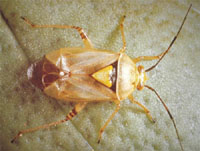Tarnished Plant Bug
Lygus lineolaris

Figure 1. Adult Tarnished Plant Bug.
Length is 1/4 inch (6 mm)
Biology
Adult tarnished plant bugs, Lygus lineolaris, are
about 1/4 inch long, brownish with yellow markings, and generally shiny
or brassy in appearance; a yellow, V-shaped mark is present on the
dorsal surface (the "top" or "back" of the insect) just behind the head.
Adults overwinter in vegetation that provides protection from extreme
cold. In the spring, they are attracted to flower buds and shoot tips of
many plants, including apple, peach, and strawberry.

Figure 2. Tarnished Plant Bug,
Adult and Nymph
Damage
Several generations of this insect develop each
year, and adults and nymphs are present on many different plants from
April or May until a heavy frost in the fall. Tarnished plant bugs use
piercing/sucking mouthparts to feed on sap from flower buds. As they
feed, they inject a toxin that kills surrounding cells. This results in
berries that remain small, with a concentration of seeds at the end of
each ripening berry. These distorted "button berries" remain woody and
unmarketable.
Control
Controlling weeds in and around strawberry fields
reduces in-field overwintering and removes sources of early-season
flowers that attract adult tarnished plant bugs to fields. However,
weeds in and near strawberry fields should not be mowed when strawberry
buds are forming and flowers are beginning to open, as tarnished plant
bugs will move from weed hosts to strawberries at a time when the crop
is especially vulnerable to damage.
Guidelines for monitoring tarnished plant bug infestations and determining whether or not to use an insecticide vary depending on whether adults or nymphs commonly cause damage in a particular region. Adults that migrate into fields appear to cause more damage than subsequent nymphs during most seasons in Illinois. Producers are advised to control tarnished plant bugs if:
- the field has suffered substantial damage from tarnished plant bugs in previous years
- tarnished plant bug adults are present in the field and sweep net samples produce more than 2 tarnished plant bug adults per 10 sweeps as buds begin to form.
Alternatively, if nymphs are present when buds are forming (particularly for later varieties or day-neutral varieties), shake flower clusters over a white pan or paper to dislodge the nymphs and count them. If counts exceed 1 nymph per 4 flower clusters or more than 10 percent of the flower clusters are infested (regardless of count), application of an insecticide is warranted. See the most recent edition of the Illinois Commercial Small Fruit and Grape Spray Guide for details on the insecticides registered for control of tarnished palnt bug in strawberries. Where tarnished plant bug control is needed, insecticides should be applied soon after blossom buds first become visible and again if reinfestation occurs just before bloom.